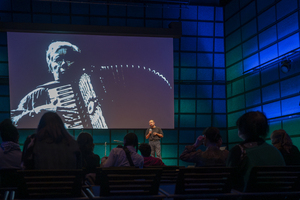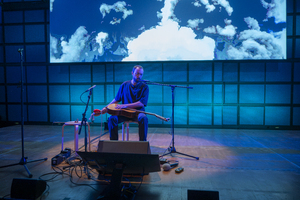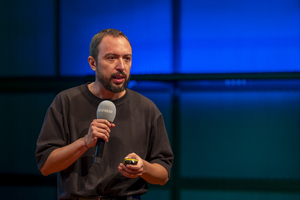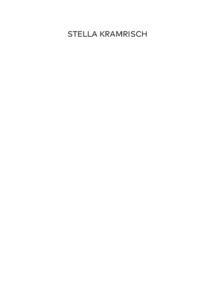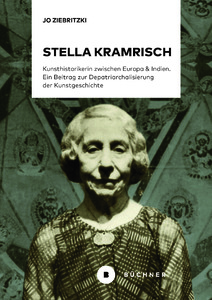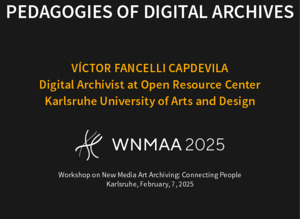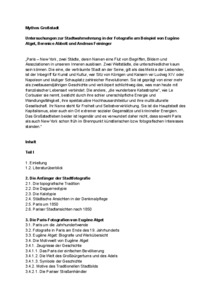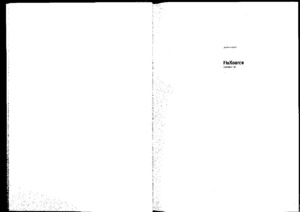"Theorie"
| Begriff | Theorie |
| Metakey | Kategorie (institution:project_category) |
| Typ | Keyword |
| Vokabular | HfG |
65 Inhalte
- Seite 1 von 6
Studies of Air and Smoke
- Titel
- Studies of Air and Smoke
- Autor/in
- Beschreibung (en)
- The talk and live music-led meditation session draws on sound design, psychology, neuroscience, folklore and diasporic spirituality. Studies of Air and Smoke is both an art performance and a meta-educational intervention; it is neither a concert nor a lecture. Thiago Leiros-Costa explores the dualism between being an artist and a scientist, performing both roles in the same evening and exploring their connections. The first part of the session assesses the nature of attention and awareness, and how the brain and our expectations are vital in constructing our experience of the world around us. Participants are invited to approach the second part, a musical performance, as a meditation session. Prompts and triggers given during the talk will be explored in the course of the performance. The music will range from folk to free improvisation and sound design.
- Kategorie
- Typ des Projekts/Werks
- Datierung
- 25.10.2024
- Sprache
- Ort: Institution
- Ort
- Media Theater
- Stadt
- Land
- Beteiligte Institution(en)
- Internetlinks
- Titel
- Studies of Air and Smoke
- Titel (en)
- Studies of Air and Smoke
- Urheberrechtshinweis
- © Thiago Leiros-Costa, After Memory, photo: Markus Breig, KIT
- Rechtsschutz/Lizenz
- Medienersteller/in
- Beziehung/Funktion
- Medien-Beschreibung
- Ein Moment der Veranstaltung „Studies of Air and Smoke“
- Medien-Beschreibung (en)
- Impressions of the Event "Studies of Air and Smoke"
- Alternativ-Text (de)
- Ein Moment der Veranstaltung "Studies of Air and Smokes"
- Alternativ-Text (en)
- Impressions of the event "Studies of Air and Smoke"
- Importiert am
- 04.12.2024
- Übergeordnete Sets
- 1
Studies of Air and Smoke
- Titel
- Studies of Air and Smoke
- Autor/in
- Beschreibung (en)
- The talk and live music-led meditation session draws on sound design, psychology, neuroscience, folklore and diasporic spirituality. Studies of Air and Smoke is both an art performance and a meta-educational intervention; it is neither a concert nor a lecture. Thiago Leiros-Costa explores the dualism between being an artist and a scientist, performing both roles in the same evening and exploring their connections. The first part of the session assesses the nature of attention and awareness, and how the brain and our expectations are vital in constructing our experience of the world around us. Participants are invited to approach the second part, a musical performance, as a meditation session. Prompts and triggers given during the talk will be explored in the course of the performance. The music will range from folk to free improvisation and sound design.
- Kategorie
- Typ des Projekts/Werks
- Datierung
- 25.10.2024
- Sprache
- Ort: Institution
- Ort
- Media Theater
- Stadt
- Land
- Beteiligte Institution(en)
- Internetlinks
- Titel
- Studies of Air and Smoke
- Titel (en)
- Studies of Air and Smoke
- Urheberrechtshinweis
- © Thiago Leiros-Costa, After Memory, photo: Markus Breig, KIT
- Rechtsschutz/Lizenz
- Medienersteller/in
- Beziehung/Funktion
- Medien-Beschreibung
- Ein Moment der Veranstaltung „Studies of Air and Smoke“
- Medien-Beschreibung (en)
- Impressions of the Event "Studies of Air and Smoke"
- Alternativ-Text (de)
- Ein Moment der Veranstaltung "Studies of Air and Smokes"
- Alternativ-Text (en)
- Impressions of the event "Studies of Air and Smoke"
- Importiert am
- 04.12.2024
- Übergeordnete Sets
- 1
Studies of Air and Smoke
- Titel
- Studies of Air and Smoke
- Autor/in
- Beschreibung (en)
- The talk and live music-led meditation session draws on sound design, psychology, neuroscience, folklore and diasporic spirituality. Studies of Air and Smoke is both an art performance and a meta-educational intervention; it is neither a concert nor a lecture. Thiago Leiros-Costa explores the dualism between being an artist and a scientist, performing both roles in the same evening and exploring their connections. The first part of the session assesses the nature of attention and awareness, and how the brain and our expectations are vital in constructing our experience of the world around us. Participants are invited to approach the second part, a musical performance, as a meditation session. Prompts and triggers given during the talk will be explored in the course of the performance. The music will range from folk to free improvisation and sound design.
- Kategorie
- Typ des Projekts/Werks
- Datierung
- 25.10.2024
- Sprache
- Ort: Institution
- Ort
- Media Theater
- Stadt
- Land
- Beteiligte Institution(en)
- Internetlinks
- Titel
- Studies of Air and Smoke
- Titel (en)
- Studies of Air and Smoke
- Urheberrechtshinweis
- © Thiago Leiros-Costa, After Memory, photo: Markus Breig, KIT
- Rechtsschutz/Lizenz
- Medienersteller/in
- Beziehung/Funktion
- Medien-Beschreibung
- Ein Moment der Veranstaltung „Studies of Air and Smoke“
- Medien-Beschreibung (en)
- Impressions of the Event "Studies of Air and Smoke"
- Alternativ-Text (de)
- Ein Moment der Veranstaltung "Studies of Air and Smokes"
- Alternativ-Text (en)
- Impressions of the event "Studies of Air and Smoke"
- Importiert am
- 04.12.2024
- Übergeordnete Sets
- 1
Studies of Air and Smoke
- Titel
- Studies of Air and Smoke
- Autor/in
- Beschreibung (en)
- The talk and live music-led meditation session draws on sound design, psychology, neuroscience, folklore and diasporic spirituality. Studies of Air and Smoke is both an art performance and a meta-educational intervention; it is neither a concert nor a lecture. Thiago Leiros-Costa explores the dualism between being an artist and a scientist, performing both roles in the same evening and exploring their connections. The first part of the session assesses the nature of attention and awareness, and how the brain and our expectations are vital in constructing our experience of the world around us. Participants are invited to approach the second part, a musical performance, as a meditation session. Prompts and triggers given during the talk will be explored in the course of the performance. The music will range from folk to free improvisation and sound design.
- Kategorie
- Typ des Projekts/Werks
- Datierung
- 25.10.2024
- Sprache
- Ort: Institution
- Ort
- Media Theater
- Stadt
- Land
- Beteiligte Institution(en)
- Internetlinks
- Titel
- Studies of Air and Smoke
- Titel (en)
- Studies of Air and Smoke
- Urheberrechtshinweis
- © Thiago Leiros-Costa, After Memory, photo: Markus Breig, KIT
- Rechtsschutz/Lizenz
- Medienersteller/in
- Beziehung/Funktion
- Medien-Beschreibung
- Ein Moment der Veranstaltung „Studies of Air and Smoke“
- Medien-Beschreibung (en)
- Impressions of the Event "Studies of Air and Smoke"
- Alternativ-Text (de)
- Ein Moment der Veranstaltung "Studies of Air and Smokes"
- Alternativ-Text (en)
- Impressions of the event "Studies of Air and Smoke"
- Importiert am
- 04.12.2024
- Übergeordnete Sets
- 1
Studies of Air and Smoke
- Titel
- Studies of Air and Smoke
- Autor/in
- Beschreibung (en)
- The talk and live music-led meditation session draws on sound design, psychology, neuroscience, folklore and diasporic spirituality. Studies of Air and Smoke is both an art performance and a meta-educational intervention; it is neither a concert nor a lecture. Thiago Leiros-Costa explores the dualism between being an artist and a scientist, performing both roles in the same evening and exploring their connections. The first part of the session assesses the nature of attention and awareness, and how the brain and our expectations are vital in constructing our experience of the world around us. Participants are invited to approach the second part, a musical performance, as a meditation session. Prompts and triggers given during the talk will be explored in the course of the performance. The music will range from folk to free improvisation and sound design.
- Kategorie
- Typ des Projekts/Werks
- Datierung
- 25.10.2024
- Sprache
- Ort: Institution
- Ort
- Media Theater
- Stadt
- Land
- Beteiligte Institution(en)
- Internetlinks
- Titel
- Studies of Air and Smoke
- Titel (en)
- Studies of Air and Smoke
- Urheberrechtshinweis
- © Thiago Leiros-Costa, After Memory, photo: Markus Breig, KIT
- Rechtsschutz/Lizenz
- Medienersteller/in
- Beziehung/Funktion
- Medien-Beschreibung
- Ein Moment der Veranstaltung „Studies of Air and Smoke“
- Medien-Beschreibung (en)
- Impressions of the Event "Studies of Air and Smoke"
- Alternativ-Text (de)
- Ein Moment der Veranstaltung "Studies of Air and Smokes"
- Alternativ-Text (en)
- Impressions of the event "Studies of Air and Smoke"
- Importiert am
- 04.12.2024
- Übergeordnete Sets
- 1
Studies of Air and Smoke
- Titel
- Studies of Air and Smoke
- Autor/in
- Beschreibung (en)
- The talk and live music-led meditation session draws on sound design, psychology, neuroscience, folklore and diasporic spirituality. Studies of Air and Smoke is both an art performance and a meta-educational intervention; it is neither a concert nor a lecture. Thiago Leiros-Costa explores the dualism between being an artist and a scientist, performing both roles in the same evening and exploring their connections. The first part of the session assesses the nature of attention and awareness, and how the brain and our expectations are vital in constructing our experience of the world around us. Participants are invited to approach the second part, a musical performance, as a meditation session. Prompts and triggers given during the talk will be explored in the course of the performance. The music will range from folk to free improvisation and sound design.
- Kategorie
- Typ des Projekts/Werks
- Datierung
- 25.10.2024
- Sprache
- Ort: Institution
- Ort
- Media Theater
- Stadt
- Land
- Beteiligte Institution(en)
- Internetlinks
- Titel
- Studies of Air and Smoke
- Titel (en)
- Studies of Air and Smoke
- Urheberrechtshinweis
- © Thiago Leiros-Costa, After Memory, photo: Markus Breig, KIT
- Rechtsschutz/Lizenz
- Medienersteller/in
- Beziehung/Funktion
- Medien-Beschreibung
- Ein Moment der Veranstaltung „Studies of Air and Smoke“
- Medien-Beschreibung (en)
- Impressions of the Event "Studies of Air and Smoke"
- Alternativ-Text (de)
- Ein Moment der Veranstaltung "Studies of Air and Smokes"
- Alternativ-Text (en)
- Impressions of the event "Studies of Air and Smoke"
- Importiert am
- 04.12.2024
- Übergeordnete Sets
- 1
Stella Kramrisch. Kunsthistorikerin zwischen Europa und Indien: Einleitung
- Titel
- Stella Kramrisch. Kunsthistorikerin zwischen Europa und Indien: Einleitung
- Autor/in
- Kategorie
- Typ des Projekts/Werks
- Titel
- Stella Kramrisch. Kunsthistorikerin zwischen Europa und Indien: Einleitung
- Urheberrechtshinweis
- © Jo Ziebritzki. Die Reproduktion als Druckerzeugnis ist untersagt.
- Rechtsschutz/Lizenz
- Freigabe Nutzung HfG
- Medienersteller/in
- Beziehung/Funktion
- Projektleiter/in
- Semester
- Studiengang
- Typ der Abschlussarbeit
- Importiert am
- 28.07.2025
- Übergeordnete Sets
- 1
Stella Kramrisch. Kunsthistorikerin zwischen Europa und Indien.
- Titel
- Stella Kramrisch. Kunsthistorikerin zwischen Europa und Indien.
- Autor/in
- Kategorie
- Typ des Projekts/Werks
- Titel
- Stella Kramrisch. Kunsthistorikerin zwischen Europa und Indien.
- Urheberrechtshinweis
- © Jo Ziebritzki
- Rechtsschutz/Lizenz
- Freigabe Nutzung HfG
- Medienersteller/in
- Beziehung/Funktion
- Projektleiter/in
- Semester
- Studiengang
- Typ der Abschlussarbeit
- Importiert am
- 28.07.2025
- Übergeordnete Sets
- 1
Pedagogies of digital archives
- Titel
- Pedagogies of digital archives
- Autor/in
- Beschreibung (de)
- Präsentation von Víctor Fancelli Capdevila, Digital Archivist beim ORC für der Schwerpunkt Connecting People im Rahmen des Workshop on New Media Art Archiving 2025, ein 3-Tägige Workshop, die in Februar 2025 in ZKM stattfand.
- Beschreibung (en)
- Presentation by Víctor Fancelli Capdevila, Digital Archivist at ORC for Connecting People part of the Workshop on New Media Art Archiving 2025, a 3-day workshop that took place in February 2025 at ZKM.
- Kategorie
- Typ des Projekts/Werks
- Schlagworte
- Datierung
- 07.02.2025
- Mitwirkende
- Dank an
- Sprache
- Technik/Verfahren/Formate
- Reveal.js
- Ort: Institution
- Ort
- ZKM Medientheater
- Stadt
- Land
- Beteiligte Institution(en)
- Internetlinks
- Titel
- Pedagogies of digital archives
- Titel (en)
- Pedagogies of digital archives
- Urheberrechtshinweis
- Víctor Fancelli Capdevila
- Rechtsschutz/Lizenz
- Medienersteller/in
- Beziehung/Funktion
- Medien-Beschreibung
- Präsentation für den Workshop on New Media Art Archiving: Connecting People
- Medien-Beschreibung (en)
- Presentation for the Workshop on New Media Art Archiving: Connecting People
- Importiert am
- 11.02.2025
- Übergeordnete Sets
- 1
Pedagogies of digital archives
- Titel
- Pedagogies of digital archives
- Autor/in
- Beschreibung (de)
- Präsentation von Víctor Fancelli Capdevila, Digital Archivist beim ORC für der Schwerpunkt Connecting People im Rahmen des Workshop on New Media Art Archiving 2025, ein 3-Tägige Workshop, die in Februar 2025 in ZKM stattfand.
- Beschreibung (en)
- Presentation by Víctor Fancelli Capdevila, Digital Archivist at ORC for Connecting People part of the Workshop on New Media Art Archiving 2025, a 3-day workshop that took place in February 2025 at ZKM.
- Kategorie
- Typ des Projekts/Werks
- Schlagworte
- Datierung
- 07.02.2025
- Mitwirkende
- Dank an
- Sprache
- Technik/Verfahren/Formate
- Reveal.js
- Ort: Institution
- Ort
- ZKM Medientheater
- Stadt
- Land
- Beteiligte Institution(en)
- Internetlinks
- Titel
- Pedagogies of digital archives
- Titel (en)
- Pedagogies of digital archives
- Urheberrechtshinweis
- Víctor Fancelli Capdevila
- Rechtsschutz/Lizenz
- Medienersteller/in
- Beziehung/Funktion
- Medien-Beschreibung
- Präsentation für den Workshop on New Media Art Archiving: Connecting People
- Medien-Beschreibung (en)
- Presentation for the Workshop on New Media Art Archiving: Connecting People
- Importiert am
- 11.02.2025
- Übergeordnete Sets
- 1
Mythos Großstadt
- Titel
- Mythos Großstadt
- Untertitel
- Untersuchungen zur Stadtwahrnehmung in der Fotografie am Beispiel von Eugène Atget, Berenice Abbott und Andreas Feininger
- Autor/in
- Beschreibung (de)
- „Paris – New York, zwei Städte, deren Namen eine Flut von Begriffen, Bildern und Assoziationen in unserem Inneren auslösen. Zwei Weltstädte, die unterschiedlicher kaum sein können. Die eine, die verträumte Stadt an der Seine, gilt als das Mekka der Liebenden, ist der Inbegriff für Kunst und Kultur, war Sitz von Königen und Kaisern wir Ludwig XIV. oder Napoleon und blutiger Schauplatz zahlreicher Revolutionen. Sie ist geprägt von einer mehr als zweitausendjährigen Geschichte und verkörpert schlichtweg das, was man heute mit französischer Lebensart verbindet. Die andere, 'die wunderbare Katastrophe', wie Le Corbusier sie nennt, besticht durch ihre schier unerschöpfliche Energie und Wandlungsfähigkeit, ihre spektakuläre Hochhausarchitektur und ihre multikulturelle Gesellschaft. Ihr Name steht für Freiheit und Selbstverwirklichung. Sie ist die Hauptstadt des Kapitalismus, aber auch ein Ort extremer sozialer Gegensätze und krimineller Energien.
Das Großstadtleben beider ist legendär und es verwundert daher nicht, dass sowohl Paris als auch New York schon früh im Brennpunkt künstlerischen bzw. fotografischen Interesses standen.”
- „Paris – New York, zwei Städte, deren Namen eine Flut von Begriffen, Bildern und Assoziationen in unserem Inneren auslösen. Zwei Weltstädte, die unterschiedlicher kaum sein können. Die eine, die verträumte Stadt an der Seine, gilt als das Mekka der Liebenden, ist der Inbegriff für Kunst und Kultur, war Sitz von Königen und Kaisern wir Ludwig XIV. oder Napoleon und blutiger Schauplatz zahlreicher Revolutionen. Sie ist geprägt von einer mehr als zweitausendjährigen Geschichte und verkörpert schlichtweg das, was man heute mit französischer Lebensart verbindet. Die andere, 'die wunderbare Katastrophe', wie Le Corbusier sie nennt, besticht durch ihre schier unerschöpfliche Energie und Wandlungsfähigkeit, ihre spektakuläre Hochhausarchitektur und ihre multikulturelle Gesellschaft. Ihr Name steht für Freiheit und Selbstverwirklichung. Sie ist die Hauptstadt des Kapitalismus, aber auch ein Ort extremer sozialer Gegensätze und krimineller Energien.
- Beschreibung (en)
- "Paris - New York, two cities whose names trigger a flood of concepts, images and associations within us. Two cosmopolitan cities that could hardly be more different. One, the dreamy city on the Seine, is considered the Mecca of lovers, is the epitome of art and culture, was the seat of kings and emperors such as Louis XIV and Napoleon and the bloody scene of numerous revolutions. It is characterized by more than two thousand years of history and simply embodies what is associated with the French way of life today. The other, 'the marvelous catastrophe', as Le Corbusier called it, captivates with its sheer inexhaustible energy and adaptability, its spectacular high-rise architecture and its multicultural society. Its name stands for freedom and self-realization. It is the capital of capitalism, but also a place of extreme social contrasts and criminal energy.
The big city life of both is legendary and it is therefore not surprising that both Paris and New York were the focus of artistic and photographic interest early on."
- "Paris - New York, two cities whose names trigger a flood of concepts, images and associations within us. Two cosmopolitan cities that could hardly be more different. One, the dreamy city on the Seine, is considered the Mecca of lovers, is the epitome of art and culture, was the seat of kings and emperors such as Louis XIV and Napoleon and the bloody scene of numerous revolutions. It is characterized by more than two thousand years of history and simply embodies what is associated with the French way of life today. The other, 'the marvelous catastrophe', as Le Corbusier called it, captivates with its sheer inexhaustible energy and adaptability, its spectacular high-rise architecture and its multicultural society. Its name stands for freedom and self-realization. It is the capital of capitalism, but also a place of extreme social contrasts and criminal energy.
- Kategorie
- Typ des Projekts/Werks
- Schlagworte
- Datierung
- 2003
- Sprache
- Ort: Institution
- Stadt
- Titel
- Mythos Großstadt
- Urheberrechtshinweis
- © Daphne Noee
- Rechtsschutz/Lizenz
- Freigabe Nutzung HfG
- Medienersteller/in
- Beziehung/Funktion
- Projektleiter/in
- Semester
- Studiengang
- Typ der Abschlussarbeit
- Archiv-Signatur
- HfG HS 2003 02
- Externes Archiv
- Importiert am
- 16.06.2024
- Übergeordnete Sets
- 1
FluXource
- Titel
- FluXource
- Untertitel
- Bibliographische Rercherche-Datenbank zu Fluxus
- Autor/in
- Kategorie
- Typ des Projekts/Werks
- Schlagworte
- Datierung
- 04.03.1999
- Sprache
- Ort: Institution
- Stadt
- Land
- Titel
- FluXource
- Urheberrechtshinweis
- © Staatliche Hochschule für Gestaltung Karlsruhe
- Rechtsschutz/Lizenz
- Freigabe Nutzung HfG
- Medienersteller/in
- Beziehung/Funktion
- Medien-Beschreibung
- Bibliographische Recherche-Datenbank zu Fluxus,
Print-Exzerpt
- Bibliographische Recherche-Datenbank zu Fluxus,
- Medien-Beschreibung (en)
- Bibliographic research database on Fluxus,
print excerpt
- Bibliographic research database on Fluxus,
- Projektleiter/in
- Semester
- Studiengang
- Typ der Abschlussarbeit
- Archiv-Signatur
- HfG HS 1999 01 2
- Externes Archiv
- Importiert am
- 16.07.2024
- Übergeordnete Sets
- 1
